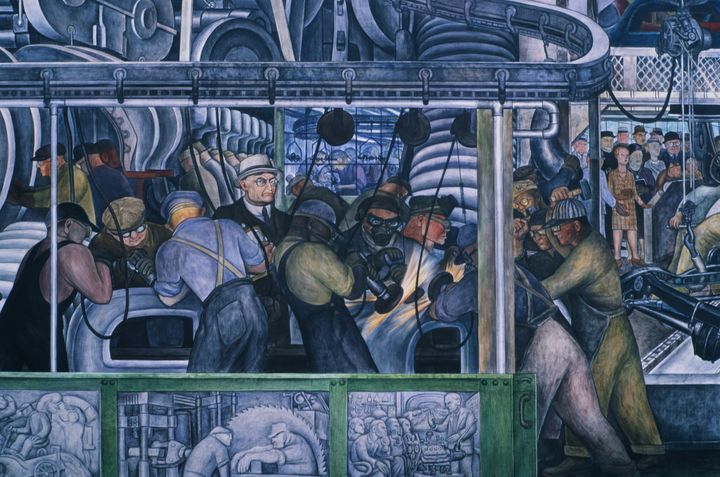
Earlier this month it was announced that the middle-class is no longer the American Majority (with the understanding that middle-class households earn somewhere between $42,000 and $126,000.) Does this mean that our middle-class jobs will continue to dwindle until there are only the ultra-rich and the working-poor? Or, is this simply an indication that the era of middle-class employment based on the working standards shaped by the industrial age are on the decline?
We can hope for the latter.
The 40-hour work was ultimately decided upon for the benefit of factory-based companies, despite often being cited as a privilege hard-won by labor unions. While it may have proven the “secret ingredient” for the later success of the industrial revolution, that standard no longer needs to dominate our cultural definition of gainful employment. Neither hours worked, nor a median income decided by the spectrum of possible salaries serve as good measurements for economic (or human) health.

This is good news, because if Jerry Kaplan (author of Humans Need Not Apply) and his peers are correct, most human jobs will soon begin to disappear anyway, thanks to programs, robotics, and artificial intelligence developments.
The bad news is that unemployed and underemployed people are not being trained to meet the needs of this post-industrial, post-consumer/service based economy.
The odds are pretty good that if you are reading this, you don’t have a full time job. In fact, if you don’t have a full time job you are likely:
- In school, ostensibly being prepared for work.
- Unemployed or underemployed.
- Disabled and unable to work.
- Retired.
This is unfortunate because every group listed above has the capacity to do something personally rewarding and world improving, with even a small amount of training. It is an inexcusable that we have created a popular myth that says important work and decent pay require a college degree. It is inexcusable that we have a culture that perpetuates the myth of a single homogenized career -- the overspecialization of individuals.
Regarding students: there are very few jobs in the 21st century that should require years of college. As many college graduates are finding, the necessary skills are learned in the field, and most training can be done in weeks.
For people who are unemployed: being sidelined or marginalized because your chosen field has been saturated, outmoded, or automated should not mandate that you go back to years of college so you can be re-trained to function in some other field.
For people who are put out of work by disability: there are many necessary and important functions that are accessible to disabled individuals.
Retired folks: there are many tasks that are low stress and high reward which would enrich the life of any (potentially bored) retiree.
What are these jobs?
If robots do everything, what’s left?

To find insights into this future, we may look for insights from the past:
Stone Age Economics by Marshall Sahlins details the lives of pre-industrial and pre-agrarian people. To prepare for a life without (conventional) jobs, it might help to review how people lived before (conventional) jobs.
How to be Idle by Tom Hodgkinson refers often to lifestyles before the industrial revolution created a full work week standard.
The 4 Hour Workweek by Tim Ferriss takes readers through many exercises tailored to prepare the individual for workweek drastically downsized by the power of automation.
What work will always need to be done? If you didn’t need money, what would you do?
First, let’s consider what sociologist Erik Olin Wright calls “capitalism between consenting adults.” That is, imagine a world where work was coerced from people via the threats of starvation, homelessness, and marginalization. Because, let’s face it, the reason most people work is to secure money in the attempt to avoid this triple threat. If machines replace most service workers, retail workers, professional workers, and government workers…then what remains? If you are guaranteed food, shelter, and status, what do you do with your days?
There are a few constants to human existence, all of which can be found in Maslow’s Hierarchy of Needs. To simplify things further, you might think of “needs” in terms of infrastructure and well-being.
Infrastructure, here, is defined by all the mechanisms that enable biological and emotional health. Well-being is provided for by the services and relationships that enhance and optimize existence. In the simplest terms, these two categories represent the total of necessary human ventures.
Another way to think of it is that which maximizes (healthy) joy and minimizes (unnecessary) suffering. These are constants. These necessary human ventures provide the cornerstones upon which anyone can build a successful career and and a successful life, whether they “work” four or forty hours per week.
Some examples of necessary infrastructure include: food, water, shelter, electricity, internet, programming, and transportation.
Examples of necessary well-being work would include: medicine, fitness, relationships, communication, community, and parenting.
Imagine if all human effort could be dedicated to the small amount of work required to bridge the few gaps left by automation in the fields listed above, and done so at self-determined pace and intensity. We'd be looking at a seriously improved quality of life.
Machines, programs, and artificial intelligence may be playing major roles in shrinking the middle-class as we know it. But, these innovations are creating opportunities that surpass the opportunities presented created for the middle-class who manufactured Ford’s Model Ts a century ago.








